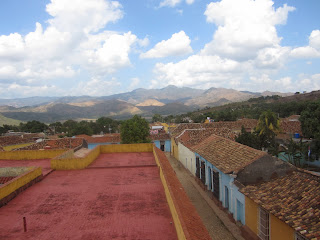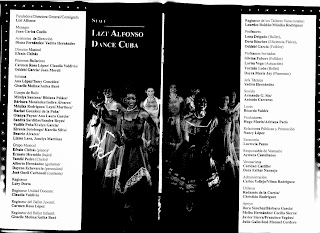 |
| Che Guevara's image in the lobby of Casa de Las Americas. |
Wednesday, February 20, was for me the most interesting day of the trip. Casa de Las Américas was stop #1. Founded by the Cuban government in April 1959, just four months after the successful conclusion of the revolution, Casa de Las Américas works to develop and extend Cuban socio-cultural relations with the countries of Latin America, the Caribbean and the rest of the world. It promotes, researches, archives, supports, awards and publishes the work of writers, sculptures, musicians, and other artists and students of literature and the arts.
It was here that our group first encountered a Cuban library, housed in Casa de las Americas' bottom floor. While by all appearances it was professionally maintained, its technology seemed a throwback to the 1990s. This observation should not be especially surprising to Cuba-watchers. Cuba is in many ways a time capsule.
My own reading has convinced me that one cannot understand the historical context of libraries in revolutionary Cuba without understanding Cuba’s national mission to eradicate illiteracy. That is why the several hours we spent at Stop #2 – the National Literacy Museum – were pivotal.
Before 1959 the official Cuban literacy rate was about 65%, with educational access in rural areas and a lack of instructors the main detriment. As a result, the Castro government dubbed 1961 the "year of education,” and sent "literacy brigades" out into the countryside to construct schools, train new educators, and teach the predominately illiterate Guajiros(peasants) to read and write. The campaign – which began on January 1 and ended on December 22, 1961 -- was "a remarkable success." By the campaign’s completion, 707,212 adults were taught to read and write, raising the national literacy rate to 96%.
The National Literacy Museum showcases that history. Though the museum is compact and modestly housed, its story is dramatic, even inspiring. There was Conrado Benitiz, a volunteer teacher who was brutally murdered by counter-revolutionaries during the campaign’s pilot stage. He became a martyr, his name a rallying cry, and before long all literacy instructors who left their homes to teach in rural zones were known as Conrado Benítiz brigadistas. There is the moving photo of the campaign’s oldest student, who, at 106 years of age, is seen learning to read and write. Remarkably, the youngest teacher was only eight years old! Several of the “literacy flags” that were raised in areas later declared free of illiteracy were displayed.
Stop #3 came after lunch and was a perfect wrap up to a most engaging day. This was the afternoon we spent with staff of the Cuban National Library, the Cuban equivalent of the Library of Congress. Though I did not take notes, my recollection of the initial stages of our hours- long group conversation focused on the wide gap that existed between Cuba’s urban and rural sectors at the time of the 1959 revolution. Such yawning gaps in education, health, and other factors -- though typical of many developing countries – were immediately targeted for remediation when the Castro government came to power. Cuban libraries were reorganized with that goal in mind as libraries and schools were built in rural areas, often in areas that hadn’t ever seen either. The Cuban National Library became the coordinator of this new centralized system.
Our conversations became increasingly open-ended and rambling as we talked about such subjects as the educational value of books like Abraham Lincoln: Vampire Hunter and efforts to bring widespread broadband internet connectivity to Cuba. The afternoon evolved from cautious smiles to open laughter. I think everyone in the room realized the rather remarkable nature of what was happening. Here we were, citizens of the United States -- Cuba’s archenemy for more than 50 years -- conversing with citizens of Cuba. Before leaving we were given an in-depth tour of the library, and by the time we left the building it was too late for what would have been stop #4, the José Martí Museum.
Casa de Las Americas
1) A book display at the Casa de Las Americas library. 2) A view of the Casa de Las Americas library electronic card catalog. 3) Two books, one entitled (in translation), "The United States Against Cuba: The War Against Terrorism and the Case of the Five." The other is "Double Standard: Cuba, The European Union, and Human Rights." 4) The Casa de Las Americas facility containes a small art museum.
Cuban National Literacy Museum
 |
This plaque quoting Castro guards the entrance to the Cuban National Literacy Museum. It says, "Cuba will be the first country in the Americas that in a matter of months is able to say it does not have one illiterate."
|
 |
| The director of the Cuban National Literacy Museum. |
 |
| The flag that was placed inside territories proclaimed free of illiteracy. |
 |
| Group discussion after the tour. |
 |
| These Brigadistas were murdered by counter-revolutionaries. |
 |
| The oldest literacy student was 106 years old |
 |
"State enterprises" play a huge role in the Cuban economy. Run like traditional businesses, they are owned by governmental entities. The restaurant where we took lunch was state owned.
|
Cuban National Library
 |
The 16 members of our tour group are present here, along with some of the Cuban library staff. Most of the Cuban staff are on the left side. I found Cubans to be easy to like, on the whole.
|
 |
| The Braille room. |
 |
| The electronic card catalog, or OPAC (Online Public Access Catalog) of the Cuban National Library. |
 |
| The old-style card catalog seemed very much still used. |
 |
| Card catalogs. |
 |
| More card catalogs. |
 |
| The two women on the left are librarians. One teaches at a library school in Wisconsin, while the other is the Director of Libraries at a communiity college in Washington state. |
 |
| Our guide Eric, on the right, translated for a group of 24 during our meeting at the Cuban National Library. I bet he slept well that night. |
 |
| The lady in blue to the left is the director of the Cuban National Library. Eric, in white, translates. . |
 |
| I know what you're probably thinking....that we should have all gone to the beach, but really I think that all or almost all of us found this experience fascinating. |
 |
| If I remember correctly, the lady in white, standing to the right, teaches high school Spanish in Missouri. |

























































